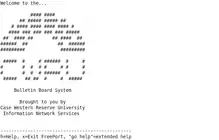Free-net
A free-net was originally a computer system or network that provided public access to digital resources and community information, including personal communications, through modem dialup via the public switched telephone network. The concept originated in the health sciences to provide online help for medical patients.[1][2] With the development of the Internet free-net systems became the first to offer limited Internet access to the general public to support the non-profit community work. The Cleveland Free-Net (cleveland.freenet.edu), founded in 1986, was the pioneering community network of this kind in the world.[3][4]

Any person with a personal computer, or through access from public terminal in libraries, could register for accounts on a free-net, and was assigned an email address. Other services often included Usenet newsgroups, chat rooms, IRC, telnet, and archives of community information, delivered either with text-based Gopher software or later the World-Wide Web.
The word mark Free-Net was a registered trademark of the National Public Telecomputing Network (NPTN), founded in 1989 by Tom Grundner at Case Western Reserve University. NPTN was a non-profit organization dedicated to establishing and developing, free, public access, digital information and communication services for the general public.[5] It closed operations in 1996, filing for Chapter 7 bankruptcy.[6] However, prior use of the term created some conflicts.[7] NPTN distributed the software package FreePort, developed at Case Western Reserve, that was used and licensed by many of the free-net sites.
The Internet domain name freenet.org was first registered by the Greater Detroit Free-Net (detroit.freenet.org), a non-profit community system in Detroit, MI, and a member of the NPTN. The Greater Detroit Free-Net provided other subdomains to several free-net systems during its operation from 1993 to approximately 2001.
Unlike commercial Internet service providers, free-nets originally provided direct terminal-based dialup, instead of other networked connections, such as Point-to-Point Protocol (PPP). The development of Internet access with cheaper and faster connections, and the advent of the World-Wide Web made the original free-net community concept obsolete.
A number of free-nets, including the original Cleveland Free-Net, have shut down or changed their focus. Free-nets have always been locally governed, so interpretation of their mission to remove barriers to access and provide a forum for community information, as well as services offered, can vary widely. As text-based Internet became less popular, some of the original free-nets have made available PPP dialup and more recently DSL services, as a revenue generating mechanism, with some now transitioning into the community wireless movement.
Several free-net systems continue under new mission statements. Rochester Free-Net (Rochester, New York), for instance, focuses on hosting community service organizations (over 500 to date) as well as seminars about Internet use to the community at no charge. Austin FreeNet (Austin, Texas) now provides technology training and access to residents of the city, "fostering skills that enable people to succeed in a digital age."[8]
See also
References
- Smith, Ernie (2018-01-20). "The Tale of the Free-Net, the Cheap Way Dial-Up Users Got Online". Motherboard. Vice. Retrieved 2018-01-31.
- Calvo, Melissa (1985-12-09). "MDs Practive Medical Arts Electronically". InfoWorld. Vol. 7, no. 49. p. 17. ISSN 0199-6649. Retrieved 2018-01-31.
- Ishida, Toru (2005). "World Digital Cities: Beyond Heterogeneity". In van den Besselaar, Peter; Koizumi, Satoshi (eds.). Digital Cities III. Information Technologies for Social Capital: Cross-cultural Perspectives. Third International Digital Cities Workshop. Information Systems and Applications. Vol. 3081. Berlin: Springer-Verlag. p. 190. ISBN 978-3-540-25971-8.
- "Cleveland Freenet". 2002. Retrieved 6 March 2021.
- Grundner, T.M. (August 4, 1991). "The National Public Telecomputing Network (NPTN)". Coalition for Networked Information. Archived from the original on 2017-01-13.
If the core beliefs of the National Public Telecomputing Network were to be summarized in one sentence, it would be this: We believe that everyone in a society has a right to access the primary information resources of that society via the best means available.
- Connors, Tim (September 24, 1996). "Goodbye to the National Public Telecomputing Network". National Public Telecomputing Network (NPTN). Archived from the original on December 25, 1996.
I regret to report that the National Public Telecomputing Network will soon be closing its doors permanently. On September 17, 1996, NPTN filed for a Chapter 7 bankruptcy.
- "Word Mark: FREE-NET". Trademark Electronic Search System (TESS). United States Patent and Trademark Office. August 2, 1988. Archived from the original on February 1, 2018. Alt URL
- "About Us: Austin Free-Net". Basic Computer Training and IT Services. Austin Free-Net. Retrieved 2018-01-31.
We exist to provide technology training and access to the community, fostering skills that enable people to succeed in a digital age.
External links
- The NPTN Blue Book, 1993 at the Wayback Machine (archived May 8, 2005) – A manual on how to create a free-net and also describes the history of community networking.
- Freenets & Community Networks Archived 2007-01-19 at the Wayback Machine – International list of freenets
- ISPbargains.com Archived 2019-10-02 at the Wayback Machine – A comprehensive updated list of free dial-up Internet service providers.
- Cleveland Free-Net Atari SIG Archive #1 - The Atari Special Interest Group (SIG) Archive is one of the only collections of preserved content from the Cleveland Free-Net.
- Cleveland Free-Net Atari SIG Archive #2 - An alternate version of the Cleveland Free-Net Atari SIG archive.
- Cleveland Free-Net tribute website - A website designed to look like the Cleveland Free-Net that provides history of the system and its users.